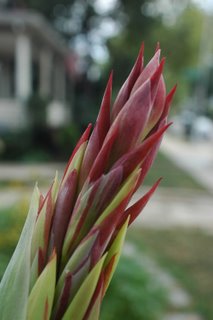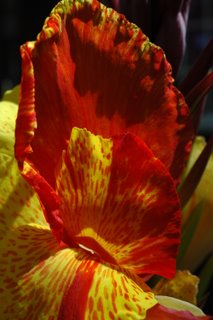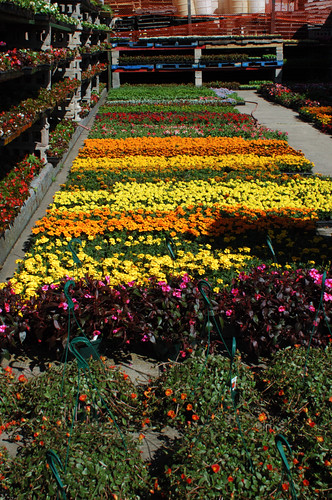Yesterday, I took my laptop out to the backyard for the first time. The wireless reception was excellent. It was a little awkward, but workable, sitting in an Adirondack chair with a laptop. Although the trees provide filtered shade, I still had to brighten the screen to its highest setting, reducing battery life. So I want a table where I can put the laptop, and a regular height chair to sit at and type or write, and an umbrella to provide more complete shade.
I’m researching a dining table, seating for at least four, and an 8′ or 9′ umbrella. I have a 7′ umbrella which is on its last legs: the bottom part of the part has rotted off, and one of the spurs has broken. A 7′ umbrella is just not large enough to provide enough shade for four people sitting around a table. I want wood, rather than metal, for its comfort, warmth, beauty, and the natural element it adds to the garden. The table must have an umbrella hole. Ideally, the table will be foldable, and the chairs foldable or stackable, for storage.
Over the years, I’ve used wooden planters and garden furniture made from cedar, teak, and “tropical hardwood.” In my experience, teak really does last several times longer in the garden than any other wood. For example, I can squeeze about five years out of a cedar planter by first treating the wood and reinforcing it with galvanized brackets; the bottom will rot out before the brackets give way. On the other hand, I have a teak planter nearly ten years old which is nearly new. My cedar furniture gets weathered, pitted, loose and weak after just a few years. My teak furniture turns grey the first winter and then nothing else happens to it. No wood is as resistant to rot, insects, and diseases as teak.
The qualms I have about teak are about whether or not, by specifying and purchasing teak as my wood of choice, I’m contributing to deforestation, habitat destruction, and so on. It’s my intent to minimize the impacts of my gardening activities, and to garden sustainably however I can. Is my teak table the equivalent of a tiger-skin rug, or an elephant foot umbrella stand? Nearly every company will claim that their teak is “ecologically harvested” or some such, whatever that means. Third-party certifications, such as those from the Forest Stewardship Council and the Rainforest Alliance, hold promise for identifying sustainable sources and holding suppliers accountable.
All I can conclude is: I can’t know for sure. The same problems arise when purchasing any wood product: a cedar bench could come from a clearcut forest in northwest North America, for all I know. In the absence of other information, my strategy is to select the highest quality and longest-lasting products I can, and to deal with reputable companies. I hope I can reduce my gardening “footprint” by using products which will last me twenty years or more, not something I will need to replace in five years.
The following suppliers are all companies I’ve dealt with over the years. In alphabetical order:
- Crate and Barrel. I like the design of their teak Trovata Round Folding Table. However, the hardware is galvanized steel, which will eventually rust and stain the wood. Any metal used outdoors other than brass must be sealed, galvanized, or allowed to oxidize or rust. For outdoor folding furniture, the best hardware is brass.
- Land’s End. They’ve just recently added an “Outdoor Living” category to their catalogs and Web site.
- Plow & Hearth. They offer furniture made from eucalyptus, cedar, and “yellow balau.” I have no experience with eucalyptus; I expect it’s comparable to cedar. Their Lakeside series is made from eucalyptus in an attractive, Mission style. I’ve never heard of “yellow balau” and assume it’s in the “tropical hardwood” category.
- Pottery Barn. They’ve recently added outdoor furniture to their offerings. Their Jayden series is teak. They have the least expensive umbrellas.
- Smith & Hawken. The original popularizer of teak garden furniture and planters. They’ve made an effort to select reputable sources. At full price, among the most expensive. I wait for sales and discounts.
- Wood Classics. My favorite company for teak furniture. They’re employee-owned and based in upstate New York. What I especially like, is that all their furniture is offered in kit form at deep discounts over the assembled, and even flat pack, pricing. This makes their teak furniture competitive with other suppliers, and gives me the satisfaction of building the furniture myself.
Links
Forest Stewardship Council
Rainforest Alliance













